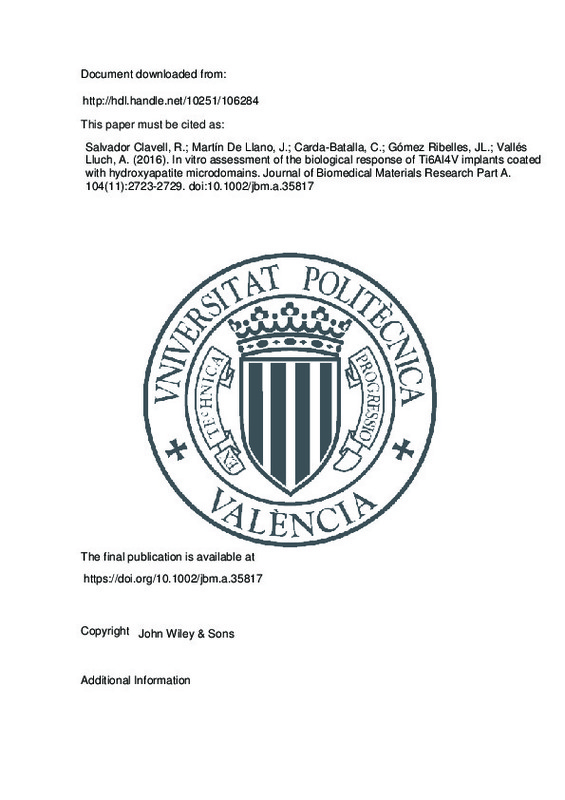JavaScript is disabled for your browser. Some features of this site may not work without it.
Buscar en RiuNet
Listar
Mi cuenta
Estadísticas
Ayuda RiuNet
Admin. UPV
In vitro assessment of the biological response of Ti6Al4V implants coated with hydroxyapatite microdomains
Mostrar el registro sencillo del ítem
Ficheros en el ítem
| dc.contributor.author | Salvador Clavell, R.
|
es_ES |
| dc.contributor.author | Martín de Llano, J.J.
|
es_ES |
| dc.contributor.author | Carda-Batalla, Carmen
|
es_ES |
| dc.contributor.author | Gómez Ribelles, José Luís
|
es_ES |
| dc.contributor.author | Vallés Lluch, Ana
|
es_ES |
| dc.date.accessioned | 2018-07-26T06:59:20Z | |
| dc.date.available | 2018-07-26T06:59:20Z | |
| dc.date.issued | 2016 | es_ES |
| dc.identifier.issn | 1549-3296 | es_ES |
| dc.identifier.uri | http://hdl.handle.net/10251/106284 | |
| dc.description.abstract | [EN] Dental implantology is still an expanding field of scientific study because of the number of people that receive dental therapies throughout their lives worldwide. Recovery times associated to dental surgery are still long and demand strategies to improve integration of metallic devices with hard tissues. In this work, an in vitro ceramic coating is proposed to improve and accelerate osseointegration of titanium surfaces conceived to be used as dental implants or hip or knee prosthesis, shaped either as dishes or screws. Such coating consists of hydroxyapatite microdomains on the implant surfaces obtained in vitro by immersion of titanium alloy samples (Ti6Al4V) in a simulated body fluid. This titanium alloy is highly used in implant dentistry and trauma surgery, among other fields. Once the immersion times under physiological conditions yielding to different ceramic topographies on this alloy were set, the acellular coating time of major interest so as to optimize its biological development was determined. For this purpose, dental pulp mesenchymal cells were cultured on titanium coated surfaces with different hydroxyapatite outline, and cell adhesion, proliferation and morphology were followed through histological techniques and scanning electron microscopy. It was found that 4 days of acellular hydroxyapatite coating led to a significant cell adhesion on the titanium alloys at an early stage (6 h). Cells tended although to detach from the surface of the coating over time, but those adhered on domains of intricated topography or hydroxyapatite cauliflowers proliferated on them, leading to isolated large cell clusters. (C) 2016 Wiley Periodicals, Inc. | es_ES |
| dc.description.sponsorship | Contract grant sponsor: CIBER-BBN through R. Salvador i Clavell grant | es_ES |
| dc.language | Inglés | es_ES |
| dc.publisher | John Wiley & Sons | es_ES |
| dc.relation.ispartof | Journal of Biomedical Materials Research Part A | es_ES |
| dc.rights | Reserva de todos los derechos | es_ES |
| dc.subject | Dental implantology | es_ES |
| dc.subject | Titanium alloy | es_ES |
| dc.subject | Hydroxyapatite | es_ES |
| dc.subject | Osseoinduction | es_ES |
| dc.subject | Osseointegration | es_ES |
| dc.subject | Simulated body fluid | es_ES |
| dc.subject.classification | MAQUINAS Y MOTORES TERMICOS | es_ES |
| dc.title | In vitro assessment of the biological response of Ti6Al4V implants coated with hydroxyapatite microdomains | es_ES |
| dc.type | Artículo | es_ES |
| dc.identifier.doi | 10.1002/jbm.a.35817 | es_ES |
| dc.rights.accessRights | Abierto | es_ES |
| dc.contributor.affiliation | Universitat Politècnica de València. Departamento de Termodinámica Aplicada - Departament de Termodinàmica Aplicada | es_ES |
| dc.description.bibliographicCitation | Salvador Clavell, R.; Martín De Llano, J.; Carda-Batalla, C.; Gómez Ribelles, JL.; Vallés Lluch, A. (2016). In vitro assessment of the biological response of Ti6Al4V implants coated with hydroxyapatite microdomains. Journal of Biomedical Materials Research Part A. 104(11):2723-2729. doi:10.1002/jbm.a.35817 | es_ES |
| dc.description.accrualMethod | S | es_ES |
| dc.relation.publisherversion | https://doi.org/10.1002/jbm.a.35817 | es_ES |
| dc.description.upvformatpinicio | 2723 | es_ES |
| dc.description.upvformatpfin | 2729 | es_ES |
| dc.type.version | info:eu-repo/semantics/publishedVersion | es_ES |
| dc.description.volume | 104 | es_ES |
| dc.description.issue | 11 | es_ES |
| dc.relation.pasarela | S\325380 | es_ES |
| dc.contributor.funder | Centro de Investigación Biomédica en Red en Bioingeniería, Biomateriales y Nanomedicina |







![[Cerrado]](/themes/UPV/images/candado.png)

